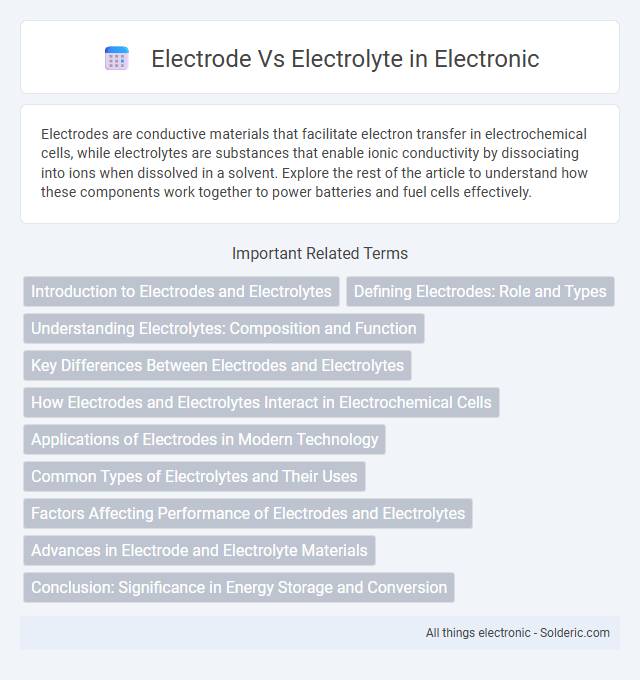Electrodes are conductive materials that facilitate electron transfer in electrochemical cells, while electrolytes are substances that enable ionic conductivity by dissociating into ions when dissolved in a solvent. Explore the rest of the article to understand how these components work together to power batteries and fuel cells effectively.
Comparison Table
| Feature | Electrode | Electrolyte |
|---|---|---|
| Definition | Conductor that facilitates electron transfer in electrochemical cells | Substance that conducts ions and completes the electric circuit |
| Function | Site for oxidation or reduction reactions | Medium for ion transport between electrodes |
| Material | Solid metals or carbon-based materials | Liquid or solid ionic compounds (salts, acids, bases) |
| Electrical Role | Conducts electrons | Conducts ions |
| Examples | Graphite electrode, platinum electrode, copper electrode | Salt solutions, acidic solutions, alkaline solutions, polymer electrolytes |
| Location in Electrochemical Cell | At cell terminals (anode and cathode) | Between the electrodes, in contact with them |
| Role in Energy Storage Devices | Stores and releases electrons during charge/discharge | Enables ion flow for charge balance |
Introduction to Electrodes and Electrolytes
Electrodes serve as the conductive surfaces in electrochemical cells where oxidation and reduction reactions occur, facilitating electron transfer. Electrolytes are ionic conductors, typically liquid or gel substances, that enable ionic movement between electrodes, maintaining electrical neutrality in the system. Understanding the distinct roles of electrodes and electrolytes is fundamental to optimizing battery performance, fuel cells, and electrolysis processes.
Defining Electrodes: Role and Types
Electrodes are conductive materials that serve as the site for oxidation and reduction reactions in electrochemical cells, playing a crucial role in electron transfer processes. Common types include anodes, which donate electrons during oxidation, and cathodes, which accept electrons during reduction. Materials for electrodes vary from metals like platinum and graphite to specialized alloys designed for specific electrochemical applications.
Understanding Electrolytes: Composition and Function
Electrolytes are substances that dissociate into ions when dissolved in a solvent, facilitating electrical conductivity in solutions. Their composition typically includes ions such as sodium, potassium, calcium, and chloride, essential for maintaining cellular function and fluid balance. Unlike electrodes that serve as conductive interfaces in electrochemical cells, electrolytes enable ion transport and chemical reactions critical to energy storage and biological processes.
Key Differences Between Electrodes and Electrolytes
Electrodes are conductive materials that facilitate electron transfer in electrochemical cells, while electrolytes are ionic substances that enable ion conduction between electrodes. Electrodes serve as sites for oxidation and reduction reactions, whereas electrolytes maintain electrical neutrality by allowing ion movement. The key difference lies in electrodes being solid conductors of electricity and electrolytes being ionic conductors in liquid, gel, or solid form.
How Electrodes and Electrolytes Interact in Electrochemical Cells
Electrodes serve as the sites for oxidation and reduction reactions, while electrolytes provide a medium for ion transport, enabling charge balance within electrochemical cells. The interaction between electrodes and electrolytes facilitates electron flow through external circuits and ion movement through the electrolyte, driving the cell's electrochemical processes. This synergy determines the cell's efficiency, voltage output, and overall performance in applications such as batteries, fuel cells, and sensors.
Applications of Electrodes in Modern Technology
Electrodes serve as critical components in batteries, fuel cells, and electrolysis devices, enabling efficient electron transfer and energy conversion. They are essential in medical devices like ECG and EEG machines for monitoring electrical activity in the human body. Advances in semiconductor electrodes have also propelled the development of sensors and electronic displays, enhancing the performance and sensitivity of modern technology.
Common Types of Electrolytes and Their Uses
Common types of electrolytes include liquid electrolytes such as sulfuric acid in lead-acid batteries and potassium hydroxide in alkaline batteries, solid electrolytes like lithium phosphorus oxynitride used in solid-state lithium-ion batteries, and polymer electrolytes employed in flexible and wearable energy storage devices. These electrolytes facilitate ion transport essential for electrochemical reactions, enabling energy storage and conversion in batteries, fuel cells, and supercapacitors. The choice of electrolyte directly impacts device performance, safety, and application range, making it a critical component in electrochemical systems.
Factors Affecting Performance of Electrodes and Electrolytes
Electrode performance is influenced by material composition, surface area, and electrical conductivity, which determine charge transfer efficiency and durability in electrochemical cells. Electrolyte properties such as ionic conductivity, viscosity, and chemical stability significantly affect ion transport and overall cell efficiency. Temperature and pH also impact both electrodes and electrolytes by altering reaction kinetics and stability, thereby shaping battery life and performance.
Advances in Electrode and Electrolyte Materials
Recent advances in electrode and electrolyte materials have significantly enhanced energy storage device performance by improving conductivity, stability, and lifespan. Innovations such as solid-state electrolytes and nanostructured electrodes optimize ion transport and reduce degradation, enabling safer and more efficient batteries. Your choice of these cutting-edge materials can directly impact the efficiency and durability of next-generation energy storage systems.
Conclusion: Significance in Energy Storage and Conversion
The distinct roles of electrodes and electrolytes are crucial for optimizing energy storage and conversion systems, with electrodes serving as sites for electron transfer and electrolytes facilitating ion movement. Efficient interaction between these components enhances charge capacity, cycle stability, and overall device performance in batteries, supercapacitors, and fuel cells. Understanding their complementary functions enables the development of advanced materials and designs for high-performance energy technologies.
Electrode vs electrolyte Infographic

 solderic.com
solderic.com